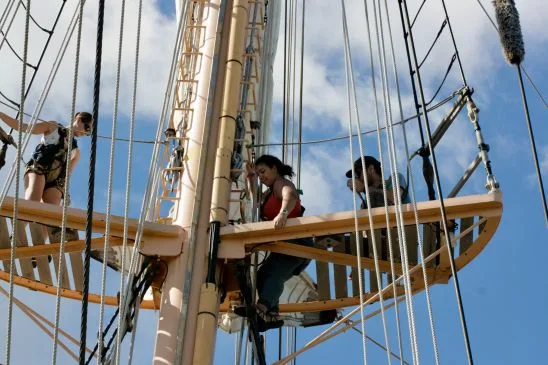Programs Blog
Getting Started

Dr. Sarah Kingston, Chief Scientist
Ship’s Log
Noon Position
17° 30.1’ S 149° 30.0’ W
Taffrail Log
7.95 nm
Weather / Wind / Sail Plan (from 1300 Watch Change)
calm, ExS winds, 1/8 cumulus, at anchor
Description of location
at anchorage near Venus Point
We wake on Day 2 a little more rested and adjusted to the new time and climate. The night before, we watched the PAUL GAUGUIN (a cruise ship) pull alongside the dock right next to us. While a dramatic approach to spectate, it didn’t take long to realize this behemoth would impede our planned exit.
Hence, we were delayed a few hours by a French Impressionist painter.
 Students Franny and Olivia get familiar with our safety equipment
Students Franny and Olivia get familiar with our safety equipment
during drills training.
Rolling with the changes, we jump into our training for the day: orientation station rotations. Students learn about watch standing and sail handling and galley and science. . . there is so much to take in. This is the first time our students get to see the wire operations – a key component of our science at sea. The sun is hot and the breeze has faded.
After an early dinner, our impressionist neighbor takes their leave and we are free for our own departure. Captain Allison deftly springs us off the dock so the bow takes a tight little turn and we can head forward into the harbor. As we head through the channel markers, it is clear we are all excited to be underway. The breeze is refreshing, the humid evening air blends with our anticipation of adventures to come. One last night’s anchorage in the cradle of Tahitian coast, Venus Point. Tomorrow – we sail!
I am eager to guide these students and crew during our Tahiti to Hawai`i crossing.
To an untrained eye, sailing tropics to tropics may seem homogenous in environmental nature, but we will cross drastic oceanographic gradients, sampling and observing along the way. We also aim to complete 4 full DNA sequencing runs along the cruise track, focused on several small fish species and eel larvae that come up to visit us each night during the largest migration on earth, the diel vertical migration. Stay tuned for accounts of our adventures from students and staff over the next ~40 days.
Dr. Sarah Kingston, Chief Scientist
Recent Posts from the Ships
- Ocean Classroom 2024-A collaborative high school program with Proctor Academy
- Collaborations and Long-term Commitments: SEA’s Caribbean Reef Program Sets a Course for Coastal Programs that Compliment Shipboard Experiences.
- Sea Education Association students prepare for life underway using state of the art nautical simulation from Wartsila Corporation.
- SEA Writer 2022, Magazines From the Summer SEA Quest Students
- Technology@SEA: Upgrades Allow Insight into Ocean Depths
Programs
- Gap Year
- Ocean Exploration
- High School
- Science at SEA
- SEA Expedition
- SEAScape
- Pre-College
- Proctor Ocean Classroom
- Protecting the Phoenix Islands
- SPICE
- Stanford@SEA
- Undergraduate
- Climate and Society
- Climate Change and Coastal Resilience
- Coral Reef Conservation
- Marine Biodiversity and Conservation
- MBL
- Ocean Exploration: Plastics
- Ocean Policy: Marine Protected Areas
- Oceans and Climate
- Pacific Reef Expedition
- The Global Ocean: Hawai'i
- The Global Ocean: New Zealand